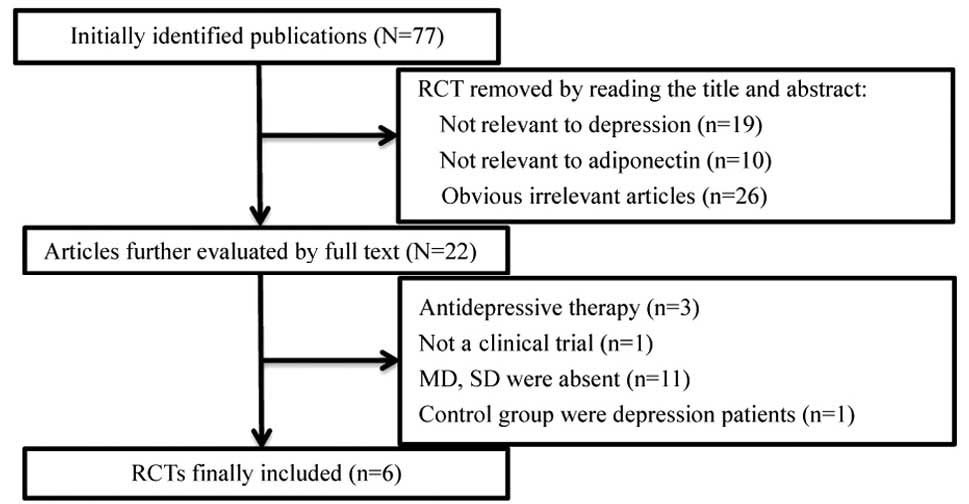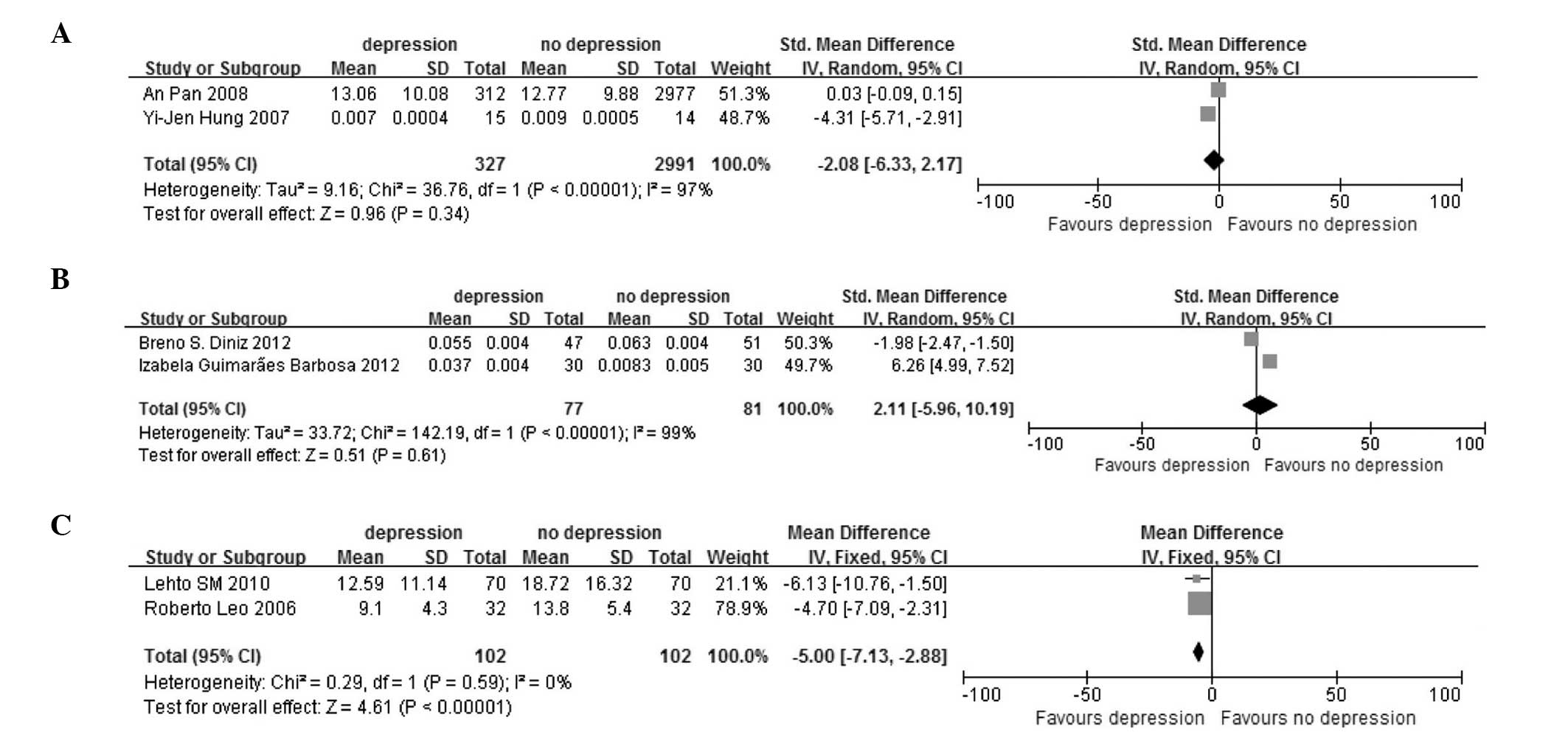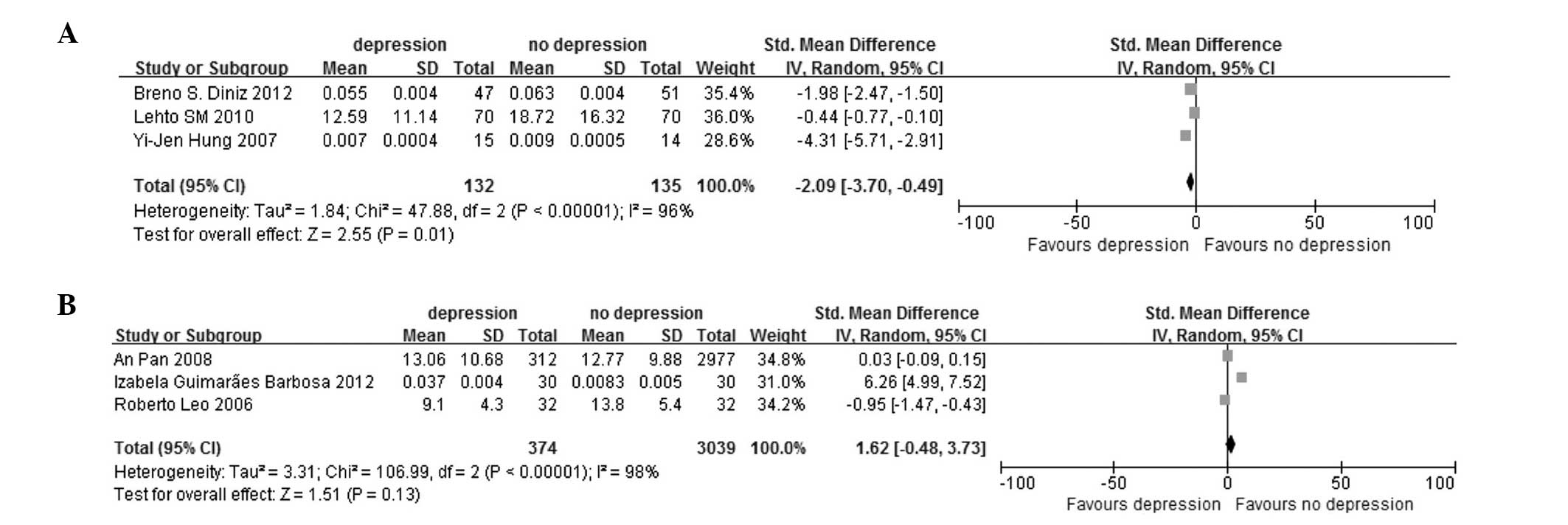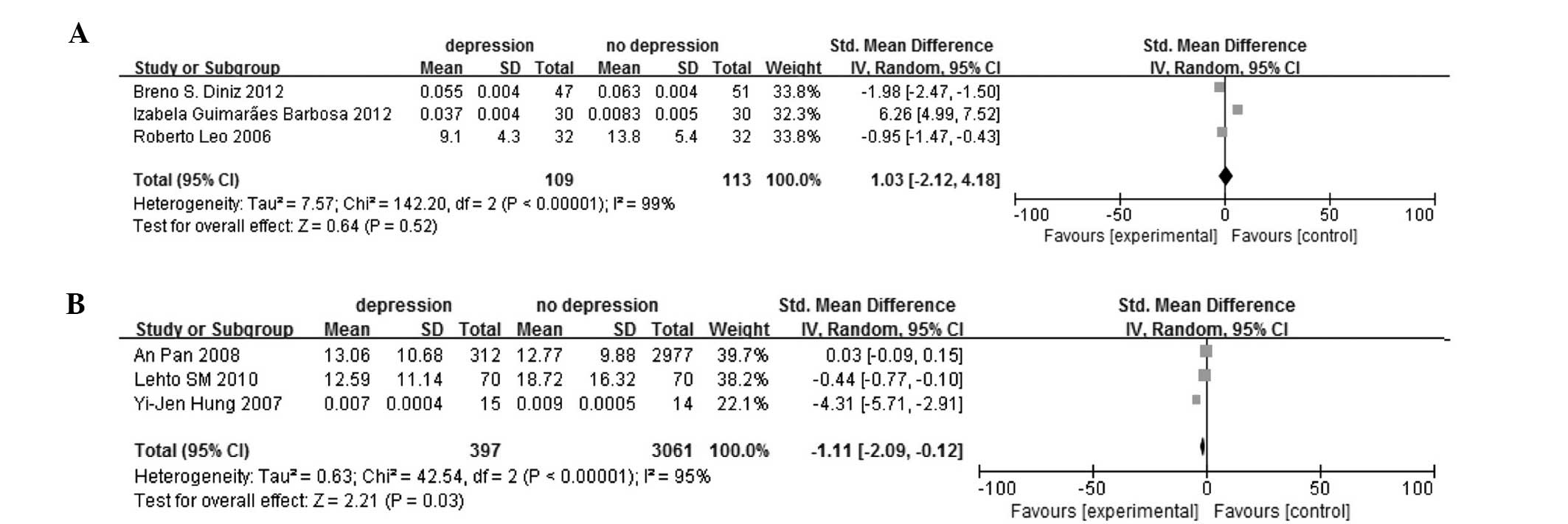Adiponectin and depression: A meta‑analysis
- Authors:
- Published online on: October 16, 2014 https://doi.org/10.3892/br.2014.372
- Pages: 38-42
Abstract
Introduction
Depression is a state of low mood and the avoidance of activity that affects a sense of well-being, thoughts, behavior and feelings (1). Depression can result in numerous feelings, including anxiety, sadness, worry, helplessness and worthlessness. Patients with depression may lose interest in activities that were previously enjoyable, have a reduction of appetite or may begin overeating, experience problems concentrating, remembering details or making decisions, and may contemplate, attempt or commit suicide. Other symptoms include insomnia, fatigue, excessive sleeping, loss of energy, or aches, pains or digestive problems (2).
Numerous studies have indicated that adiponectin is associated with depression (3). Adiponectin is secreted into the bloodstream from adipose tissue only and compared to a number of hormones, it is extremely abundant in the plasma (4). Adiponectin has also been shown to regulate glucose levels and fatty acid breakdown (5). However, there has been no meta-analysis to clarify the precise associations between adiponectin levels and depression. The present study investigated whether adiponectin is associated with depression by performing a meta-analysis of the available data from previous studies.
Materials and methods
Selection of studies
Information was carefully extracted from all the eligible studies by two investigators (Yaozhi Hu and Xiaomeng Dong) independently, using a standardized data extraction form. Any disagreements were resolved by discussion during a consensus meeting with a third investigator (Jinbo Chen). A search through the electronic databases, including PubMed, Cochrane Central Register of Controlled Trials and Embase, and the following Chinese databases: The China National Knowledge Infrastructure, China Biology Medicine disc, VIP Database for Chinese Technical Periodicals and Wan Fang Data, were conducted for studies using the key words ‘adiponectin’ and ‘depression’ for the relevant citations. The reference lists of retrieved reviews and studies were manually screened. The publication language was restricted to English or Chinese. The literature search was updated on June 20, 2014.
Selection criteria
The selection criteria used to determine the eligible studies included: i) Study design should be a randomized controlled trial; ii) depression was diagnosed by the Diagnostic and Statistical Manual of Mental Disorders IV (DSM-IV) (6), Center for Epidemiologic Studies Depression Scale or Mini-International Neuropsychiatric Interview; iii) the control group must be healthy subjects whose age and gender matched the patients with depression; and iv) overnight fasting antecubital vein blood samples were collected from each consenting subject.
Data extraction
The following information was extracted from the eligible studies: i) Name of the first author, ii) year of publication, iii) region, iv) sample size of the subjects with and without depression, v) diagnostic instrument, vi) age, vii) the type of blood sample and viii) the technique that was used for detecting adiponectin levels.
Statistical analysis
In order to estimate the association between the adiponectin levels and depression, the standardized mean difference (SMD) and 95% confidence interval (CI) from each study were calculated using Cochrane Collaboration's Review Manager 5.2 software (The Nordic Cochrane Centre, Copenhagen, Denmark). The heterogeneity of SMDs was assessed by using the Cochran's Q test and I2. When heterogeneity was present, SMDs were pooled using the random-effects model (the DerSimonian and Laird method). Otherwise, the fixed-effects model (the Mantel-Haenszel method) was used. The statistical significance of the pooled SMDs was analyzed using the Z test. For the studies with insufficient information, the investigators contacted the primary researchers to acquire and verify data whenever possible.
Results
Characteristics of the studies
There were 77 studies relevant to the search words. Through screening the title and reading the entire study, six eligible studies were selected for additional analysis. The flow diagram shows the detailed process of selection (Fig. 1). The total data of the six studies (7–12) were gathered from 506 patients with depression and 3,714 controls worldwide. Of the six studies, DSM-IV was used for diagnosing depression in four studies (Table I).
Results of the meta-analysis. In the present continuous variable meta-analysis, tests for heterogeneity were first performed (I2=98%, P<0.00001) and subsequently the random-effect model (SMD, −0.28; 95% CI, −1.37 to 0.81), but not the fixed-effect model (Fig. 2), and subgroup analysis were carried out according to their region, age, blood sample and detection method. In the region group were the Chinese (SMD, −2.08; 95% CI, −6.33 to 2.17; P<0.00001 for heterogeneity, by random-effect model; Fig. 3A), Brazilian (SMD, 2.11; 95% CI, −5.96 to 10.19; P<0.00001 for heterogeneity, by random-effect model; Fig. 3B) and European subgroups (SMD, −5.00; 95% CI, −7.13 to −2.88; P=0.59 for heterogeneity, by fixed-effect model; Fig. 3C). In the age group were the older (mean age, >50 years) (SMD, −0.77; 95% CI, −1.75 to 0.21; P<0.00001 for heterogeneity, by random-effect model; Fig. 4A) and younger subgroups (mean age, <50 years) (SMD, 0.33; 95% CI, −4.68 to 5.34; P<0.00001 for heterogeneity, by random-effect model; Fig. 4B). The serum (SMD, −2.09; 95% CI, −3.70 to −0.49; P<0.00001 for heterogeneity, by random-effect model; Fig. 5A) and plasma subgroups (SMD, 1.62; 95% CI, −0.48 to 3.73; P<0.00001 for heterogeneity, by random-effect model; Fig. 5B) were present in the blood sample group. In the method group, the ELISA, which was used for detecting adiponectin levels, (SMD, 1.03; 95% CI, −2.12 to 4.18; P<0.00001 for heterogeneity, by random-effect model; Table II and Fig. 6A) and not ELISA subgroups (SMD, −1.11; 95% CI, −2.09 to −0.12; P<0.00001 for heterogeneity, by random-effect model; Fig. 6B) were assessed.
The investigators did not draw a funnel plot based on the comparison of the adiponectin levels in plasma of two groups (depression verses no depression) due to the small sample size.
Discussion
Depression is a common psychiatric disorder with a 10–20% lifetime prevalence rate (13). Depressive disorder is a complex and multifactorial disorder with biological heterogeneity. Increasing evidence indicates that the mood disorder is associated with insulin resistance and inflammation (14,15). As an anti-inflammatory cytokine, the adiponectin level will decrease in patients with depression (16). There has been particular inconsistency, with certain studies in support of this finding and others not. In the present meta-analysis, data was extracted from six eligible studies, including a total of 506 patients with depression and 3,714 controls. Furthermore, all the relevant studies published in English or Chinese were included for the meta-analysis, which reduced language biases. The results indicate that there was no significant association between the adiponectin level and depression in all the included populations, but patients with depression had a lower adiponectin level in the European subgroup when compared to healthy subjects. This analogous situation did not occur in the Chinese or Brazilian subgroups. Although subgroup analysis may produce false positive result due to small sample size, it also demonstrates a tendency in certain ways. Different region and ethnic lines may cause heterogeneities.
Intracerebroventricular administration of adiponectin produces an antidepressant-like effect in mice (3). The same study also described that a chronic social defeat (depression model) reduces circulating adiponectin concentrations. Adiponectin stimulated proliferation of adult hippocampal neural stem cells through activation of p38 mitogen-activated protein kinase/glycogen synthase kinase 3β/β-catenin signaling cascade (17). These studies demonstrated that mice with depression had a lower adiponectin level and it also described the mechanism of antidepressant-like activity regarding adiponectin. These results may consistent with European subgroup in humans being in our meta-analysis.
In one clinical trial, premenopausal females with major depression exhibited lower circadian plasma adiponectin concentrations compared to the closely matched control subjects (18), and it detected adiponectin level once an hour, which lead to the exclusion of the study from the present meta-analysis. High molecular weight adiponectin/total adiponectin was also negatively associated with the depression score (19). In addition, numerous studies had other views. Mamalakis et al found that serum adiponectin was not associated with depression in adolescents (20). Jeong et al (21) also described that the plasma adiponectin concentration was elevated in subsyndromal depression patients. A significantly positive correlation between plasma adiponectin levels and the BDI-II cognitive-affective factor measure was also found in another study (22). Approximately six studies included in the present study found that adiponectin levels were present as pg/ml or µg/ml, and these were subsequently calculated into µg/ml simultaneously. An enormous difference appeared in these values, which may be associated with age, region and ethnicity. The heterogeneity of the European subgroup was appropriate and patients with depression had a lower adiponectin level compared to healthy controls. A number of animal experiments and a section of clinical trials were in accord with this conclusion, but a consistent conclusion could not be reached due to limited clinical data.
However, there were limitations of the meta-analysis, which included the small number of studies and subjects in the studies that were in the specific subgroups. Therefore, larger samples sizes are required in more studies.
In conclusion, the results of the present study indicate that the association between adiponectin levels and depression was not clarified in all the different populations, but the adiponectin levels of patients with depression were lower in the European subgroup. Due to the limitations mentioned, additional investigations should be performed to investigate these associations.
References
|
Silva MT, Galvao TF, Martins SS and Pereira MG: Prevalence of depression morbidity among Brazilian adults: a systematic review and meta-analysis. Rev Bras Psiquiatr. 36:262–270. 2014. View Article : Google Scholar : PubMed/NCBI | |
|
Johnson J, Weissman MM and Klerman GL: Service utilization and social morbidity associated with depressive symptoms in the community. JAMA. 267:1478–1483. 1992. View Article : Google Scholar : PubMed/NCBI | |
|
Liu J, Guo M, Zhang D, et al: Adiponectin is critical in determining susceptibility to depressive behaviors and has antidepressant-like activity. Proc Natl Acad Sci USA. 109:12248–12253. 2012. View Article : Google Scholar : PubMed/NCBI | |
|
Adam T, Schamarek I, Springer EA, Havel PJ and Epel EE: Adiponectin and negative mood in healthy premenopausal and postmenopausal women. Horm Behav. 58:699–704. 2010. View Article : Google Scholar : PubMed/NCBI | |
|
Jaziri R, Aubert R, Roussel R, et al DIABHYCAR SURDIAGENE Study Groups: Association of ADIPOQ genetic variants and plasma adiponectin isoforms with the risk of incident renal events in type 2 diabetes. Nephrol Dial Transplant. 25:2231–2237. 2010. View Article : Google Scholar : PubMed/NCBI | |
|
Kessler RC, Birnbaum HG, Shahly V, et al: Age differences in the prevalence and co-morbidity of DSM-IV major depressive episodes: results from the WHO World Mental Health Survey Initiative. Depress Anxiety. 27:351–364. 2010. View Article : Google Scholar : PubMed/NCBI | |
|
Barbosa IG, Rocha NP, de Miranda AS, et al: Increased levels of adipokines in bipolar disorder. J Psychiatr Res. 46:389–393. 2012. View Article : Google Scholar : PubMed/NCBI | |
|
Leo R, Di Lorenzo G, Tesauro M, et al: Decreased plasma adiponectin concentration in major depression. Neurosci Lett. 407:211–213. 2006. View Article : Google Scholar : PubMed/NCBI | |
|
Hung YJ, Hsieh CH, Chen YJ, et al: Insulin sensitivity, proinflammatory markers and adiponectin in young males with different subtypes of depressive disorder. Clin Endocrinol (Oxf). 67:784–789. 2007. View Article : Google Scholar : PubMed/NCBI | |
|
Diniz BS, Teixeira AL, Campos AC, et al: Reduced serum levels of adiponectin in elderly patients with major depression. J Psychiatr Res. 46:1081–1085. 2012. View Article : Google Scholar : PubMed/NCBI | |
|
Lehto SM, Huotari A, Niskanen L, et al: Serum adiponectin and resistin levels in major depressive disorder. Acta Psychiatr Scand. 121:209–215. 2010. View Article : Google Scholar : PubMed/NCBI | |
|
Pan A, Ye X, Franco OH, et al: The association of depressive symptoms with inflammatory factors and adipokines in middle-aged and older Chinese. PLoS One. 3:e13922008. View Article : Google Scholar : PubMed/NCBI | |
|
Hasin DS, Goodwin RD, Stinson FS and Grant BF: Epidemiology of major depressive disorder: results from the National Epidemiologic Survey on Alcoholism and Related Conditions. Arch Gen Psychiatry. 62:1097–1106. 2005. View Article : Google Scholar : PubMed/NCBI | |
|
Miller AH, Maletic V and Raison CL: Inflammation and its discontents: the role of cytokines in the pathophysiology of major depression. Biol Psychiatry. 65:732–741. 2009. View Article : Google Scholar : PubMed/NCBI | |
|
Steinman L: Nuanced roles of cytokines in three major human brain disorders. J Clin Invest. 118:3557–3563. 2008. View Article : Google Scholar : PubMed/NCBI | |
|
Ouchi N, Kihara S, Funahashi T, Matsuzawa Y and Walsh K: Obesity, adiponectin and vascular inflammatory disease. Curr Opin Lipidol. 14:561–566. 2003. View Article : Google Scholar : PubMed/NCBI | |
|
Zhang D, Guo M, Zhang W and Lu XY: Adiponectin stimulates proliferation of adult hippocampal neural stem/progenitor cells through activation of p38 mitogen-activated protein kinase (p38MAPK)/glycogen synthase kinase 3β (GSK-3β)/β-catenin signaling cascade. J Biol Chem. 286:44913–44920. 2011. View Article : Google Scholar : PubMed/NCBI | |
|
Cizza G, Nguyen VT, Eskandari F, et al POWER Study Group: Low 24-hour adiponectin and high nocturnal leptin concentrations in a case-control study of community-dwelling premenopausal women with major depressive disorder: the Premenopausal, Osteopenia/Osteoporosis, Women, Alendronate, Depression (POWER) study. J Clin Psychiatry. 71:1079–1087. 2010. View Article : Google Scholar : PubMed/NCBI | |
|
Narita K, Murata T, Hamada T, et al: Adiponectin multimer distribution, not absolute amount of plasma, correlates with depression severity in healthy elderly subjects. Prog Neuropsychopharmacol Biol Psychiatry. 32:124–127. 2008. View Article : Google Scholar | |
|
Mamalakis G, Kiriakakis M, Tsibinos G, et al: Depression and serum adiponectin and adipose omega-3 and omega-6 fatty acids in adolescents. Pharmacol Biochem Behav. 85:474–479. 2006. View Article : Google Scholar : PubMed/NCBI | |
|
Jeong HG, Min BJ, Lim S, et al: Plasma adiponectin elevation in elderly individuals with subsyndromal depression. Psychoneuroendocrinology. 37:948–955. 2012. View Article : Google Scholar : PubMed/NCBI | |
|
Wilhelm CJ, Choi D, Huckans M, Manthe L and Loftis JM: Adipocytokine signaling is altered in Flinders sensitive line rats, and adiponectin correlates in humans with some symptoms of depression. Pharmacol Biochem Behav. 103:643–651. 2013. View Article : Google Scholar : PubMed/NCBI |















